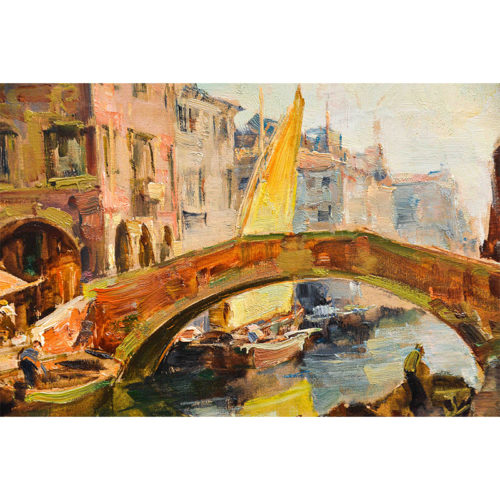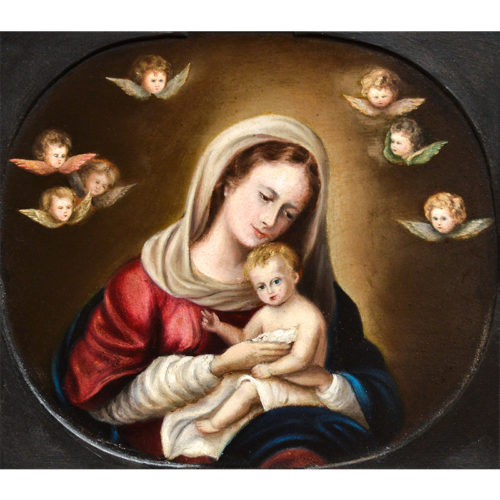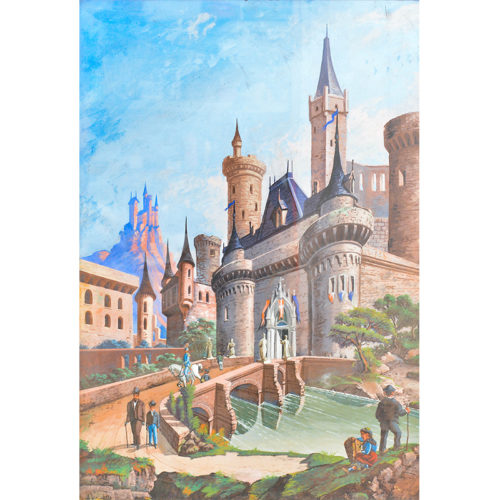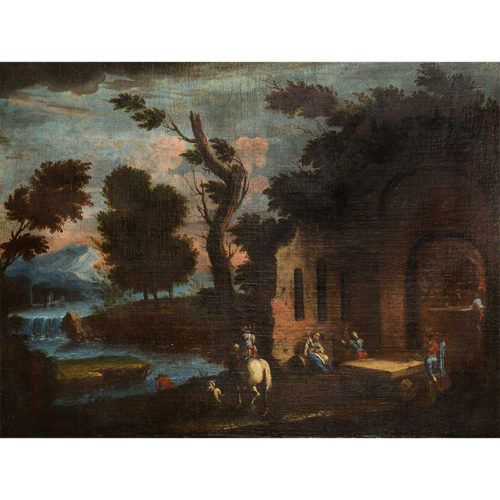"Ponte dal Vigo, Canal Vena, Chioggia" - Oil on canvas by Angelo Brombo (1893-1962), dating back to the 1940s / 1950s. Signed on the lower right.
BROMBO ANGELO. Born in Chioggia on January 5, 1893, he moved to Venice. He participated in the exhibitions in Venice Rome, Turin, Naples and other minor ones, from the Veneto region, with flattering success, and also in Rome in 1926 at the Mostra d'Arte Marinara, in Milan the following year, at the Primavera; in Bologna, Como, Rovigo; again in Rome; in Milan at the Mostra Peschereccia in 1939, where he obtained the gold medal of the Ministry of Agriculture. He has held solo shows in many Italian cities, receiving praise from the public and flattering judgments from critics for his personal, moving evidence in the marine theme. He has many works in private collections and among them: Polichromie chioggiotte (Conte Molini collection of Venice), Sails, Vita chioggiotta, La riva dei Rigattieri, Gray days, Shopping on board, Campo del Duomo (Pennasilico collection). Other works in public collections: The Mausoleum of Diocletian in Split (Capitoline Museum in Rome), Ruins of Nona (Collez. Comunale di Perugia), La Vela (Municipality of Cavarzere).
-
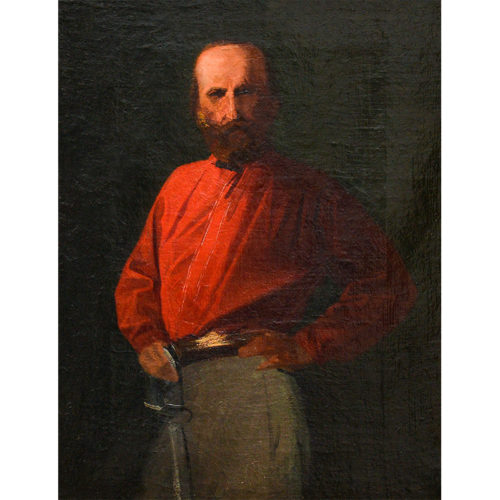 Period: 19th century Measurements: H 50 x L 41 x P 4.5 / Canvas H 39 x L 31 cm"Garibaldi" - Oil on canvas by Teofilo Patini (1840-1906) PATINI TEOFILO. Born in Castel di Sangro (L'Aquila) on May 5, 1840, died in Naples on November 16, 1906. He moved to Naples at a very young age, after graduating in Fine Arts; he enrolled at the Institute of Fine Arts, where Filippo Palizzi was teaching at the time. During the courses he easily won several prizes and finally obtained a pensioner to go to Rome, where he studied deeply the ancient masters and in particular those of the seventeenth century. He also was strongly influenced from Dutch paintings, but, above all, it was the Meissonnier who conquered him. He first dealt, for a short period of time, with the historical picture; then, with his sensitive and scornful soul, as an attentive observer of the events of human life, he gave himself to social painting, expressed with a strong and meticulous verism. His masterpiece is L'erede, which was exhibited in Milan in 1881 and is now found in the Gallery of Modern Art in Rome with Spade and Milk, exhibited in Turin in 1884. Other important paintings of his are: Il Parmigianino; The sack of Rome, of the Municipality of Naples; Art and freedom; Salvator Rosa's studio, exhibited in Turin in 1880 and in Vienna; Every good boot becomes a slipper; The first riding lesson, which is owned by the baritone Titta Ruffo; Pack animals, sent to Venice in 1887; Rocky landscape, in the M.O. collection of Milan; The riding lesson, in the Borgogna Museum of Vercelli; The country doctor; Belly and heart; The company of death: After defeat; The good ones; The notables of my country; The eagle; The caralluccio; Return to the sheepfold; The chain. Patini also tried, with less success, the sacred subject, and the paintings are remembered in this regard: Gloria del Sacramento; The temptations of Saint Anthony; Christ in the garden; The Redeemer; Christ raises the widow's son; The Annunziata; Il Purgatorio: The Crucifix; The Guardian Angel; Sant'Antonio di Padova; San Carlo Borromeo. There are also the sketches for the decorations of the Aula Magna of the University of Naples (work that, for the artist's death, remained unfinished), and the frescoes in the hall of the City Council of the same city. His students include M. Dragonetti Cappelli, E. Rubei, Vittor Scarselli.
Period: 19th century Measurements: H 50 x L 41 x P 4.5 / Canvas H 39 x L 31 cm"Garibaldi" - Oil on canvas by Teofilo Patini (1840-1906) PATINI TEOFILO. Born in Castel di Sangro (L'Aquila) on May 5, 1840, died in Naples on November 16, 1906. He moved to Naples at a very young age, after graduating in Fine Arts; he enrolled at the Institute of Fine Arts, where Filippo Palizzi was teaching at the time. During the courses he easily won several prizes and finally obtained a pensioner to go to Rome, where he studied deeply the ancient masters and in particular those of the seventeenth century. He also was strongly influenced from Dutch paintings, but, above all, it was the Meissonnier who conquered him. He first dealt, for a short period of time, with the historical picture; then, with his sensitive and scornful soul, as an attentive observer of the events of human life, he gave himself to social painting, expressed with a strong and meticulous verism. His masterpiece is L'erede, which was exhibited in Milan in 1881 and is now found in the Gallery of Modern Art in Rome with Spade and Milk, exhibited in Turin in 1884. Other important paintings of his are: Il Parmigianino; The sack of Rome, of the Municipality of Naples; Art and freedom; Salvator Rosa's studio, exhibited in Turin in 1880 and in Vienna; Every good boot becomes a slipper; The first riding lesson, which is owned by the baritone Titta Ruffo; Pack animals, sent to Venice in 1887; Rocky landscape, in the M.O. collection of Milan; The riding lesson, in the Borgogna Museum of Vercelli; The country doctor; Belly and heart; The company of death: After defeat; The good ones; The notables of my country; The eagle; The caralluccio; Return to the sheepfold; The chain. Patini also tried, with less success, the sacred subject, and the paintings are remembered in this regard: Gloria del Sacramento; The temptations of Saint Anthony; Christ in the garden; The Redeemer; Christ raises the widow's son; The Annunziata; Il Purgatorio: The Crucifix; The Guardian Angel; Sant'Antonio di Padova; San Carlo Borromeo. There are also the sketches for the decorations of the Aula Magna of the University of Naples (work that, for the artist's death, remained unfinished), and the frescoes in the hall of the City Council of the same city. His students include M. Dragonetti Cappelli, E. Rubei, Vittor Scarselli. -
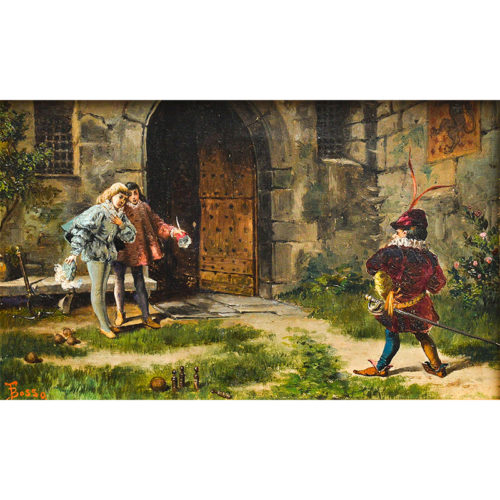 Epoca: Fine '800 Misure: In cornice H 38 x L 46 / Tavola H 16 x L 26,8 cm"The challenge" - Oil on cardboard by Francesco Bosso (1864-1933) BOSSO FRANCESCO. Born in Vercelli on December 27, 1864, died in Turin in 1933. He studied at the Institute of Fine Arts in his city with Bonino and Costa. At the beginning of his artistic career he devoted himself to decoration and scenography, performing several works in palaces, churches and theaters of Italy, France and Switzerland. For the Colonial Exhibition in Genoa he composed a large Diorama of the Panama Canal, appreciated and praised. He especially dedicated himself to the paintings of flowers, fruit and still lifes, which brought him wide fame. In 1922 forty-seven of his paintings were exhibited at the Vercelli Art Exhibition, including: Sun from the glass windows; Rustic rooms in Tournier; Among the rocks; Autumn melancholy; Fontanesian landscape and still lives.
Epoca: Fine '800 Misure: In cornice H 38 x L 46 / Tavola H 16 x L 26,8 cm"The challenge" - Oil on cardboard by Francesco Bosso (1864-1933) BOSSO FRANCESCO. Born in Vercelli on December 27, 1864, died in Turin in 1933. He studied at the Institute of Fine Arts in his city with Bonino and Costa. At the beginning of his artistic career he devoted himself to decoration and scenography, performing several works in palaces, churches and theaters of Italy, France and Switzerland. For the Colonial Exhibition in Genoa he composed a large Diorama of the Panama Canal, appreciated and praised. He especially dedicated himself to the paintings of flowers, fruit and still lifes, which brought him wide fame. In 1922 forty-seven of his paintings were exhibited at the Vercelli Art Exhibition, including: Sun from the glass windows; Rustic rooms in Tournier; Among the rocks; Autumn melancholy; Fontanesian landscape and still lives. -
Out of stock
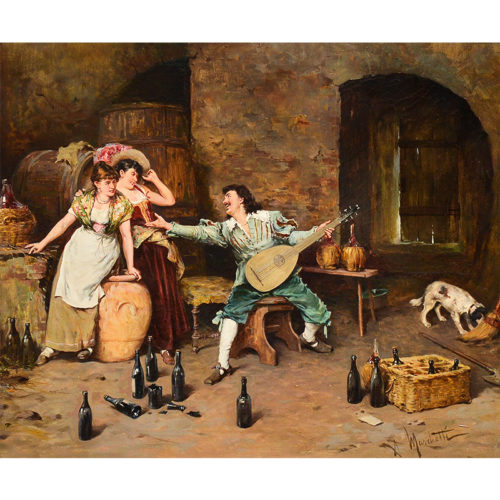 Period: Late 19th century Measures: In frame H 74 x L 85 x P 9 / Canvas H 50 x L 60 cm"Interior scene with characters" - Oil on canvas, signed on the lower right corner "Marchetti", dating back to the end of the 19th century, of beautiful quality and definition.
Period: Late 19th century Measures: In frame H 74 x L 85 x P 9 / Canvas H 50 x L 60 cm"Interior scene with characters" - Oil on canvas, signed on the lower right corner "Marchetti", dating back to the end of the 19th century, of beautiful quality and definition. -
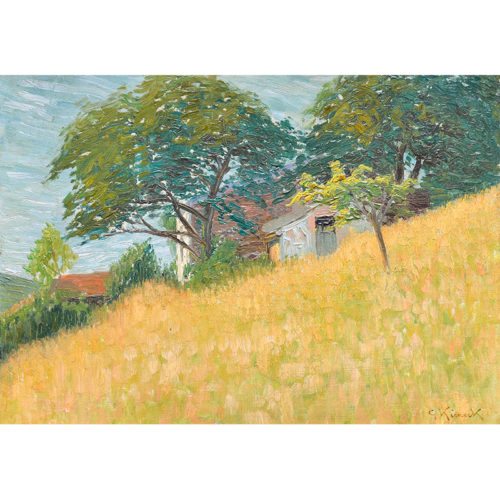 Period: 30s / 40s Measures: H 44 x L 55 x P 6 / Tablet H 26 x L 35 cm"Landscape" - Oil on tablet by Giorgio Kienerk (1869-1948). Signed on the lower right. The work was already sold in Martini auction in December 2011. KIENERK GIORGIO. He was born in Florence, in an ancient Tuscan family, on May 5, 1869. He studied with Adriano Cecioni, then, recommended by Telemaco Signorini, he dedicated himself not only to sculpture but also to painting. He formed, therefore, alongside Macchiaioli and made his debut very early, exhibiting six small landscapes at the Promotrice of Florence in 1888. He continued annually to present paintings and statues there. From 1891 to 1895 he followed the Divisionist school and painted, among other things, In riva all'Arno and Mattino sul mare. In 1897 he exhibited two large pastel female portraits at the Internationale of art and flowers in Florence and then oriented himself towards large figures, often with an allegorical meaning. In 1898 he appeared in Turin with Dolore. Then he participated in the Venetian Biennials with La vergognosa (1899), Il Silenza (1901), the Portrait of Irma Gramatica, pastel (1903), Sera, drawing (1905). He then came to the main Italian and foreign exhibitions in Brussels, Munich, Vienna, London, Saint Louis, Buenos Aires. With his scratched, borderless drawings, he has collaborated in magazines and newspapers (La Fiammetta, No-vissima, L'Italia ride, La Domenica dell'Avanti, La Liguria ligure, Numero, Gil Blas and Cocoricò dì Parigi). In 1905 he was appointed director of the civic painting school of Pavia. In the early period Pavia was particularly interested in sculpture, especially bronze plaques, a genre that he cultivated for a long time. After 1913, thanks to the experience acquired with the studies on Divisionism and mindful of the research of colors and light of the early years, he returned to deal with landscape and from then until his death the campaign was a continuous source of inspiration, especially after 1920 when he started working in Fauglia, on the Pisan hills (The washerwomen, Under the olive tree, In the shadow of the Carob tree, Dusty road). The portraits also belong to his last production (Portrait of the Marquis Quaratesi). In 1922 he exhibited in Florence at the Fiorentina Spring and until 1936 several times in Pavia. In 1936, finishing his teaching at the school of painting, many works were purchased by the Municipality of Pavia and are located in the museum of that city. From 1937 to 1943 he lived in Florence, exhibiting in various solo shows in Florence itself and also in Lucca and Livorno. In 1947 an exhibition of his works was opened at the Galleria Geri in Milan. Retiring to Fauglia with his family in 1943, he died in his villa in Poggio alla Farnia on February 15, 1948. His works can be found in the Modern Art Galleries of Venice, Florence, Lima (Peru) and in the Museum of Brussels. Many are in private collections in Pavia, Milan, where in the Turri Collection there is a Girl's Head, in Genoa, Florence. He engraved some drypoint plates.
Period: 30s / 40s Measures: H 44 x L 55 x P 6 / Tablet H 26 x L 35 cm"Landscape" - Oil on tablet by Giorgio Kienerk (1869-1948). Signed on the lower right. The work was already sold in Martini auction in December 2011. KIENERK GIORGIO. He was born in Florence, in an ancient Tuscan family, on May 5, 1869. He studied with Adriano Cecioni, then, recommended by Telemaco Signorini, he dedicated himself not only to sculpture but also to painting. He formed, therefore, alongside Macchiaioli and made his debut very early, exhibiting six small landscapes at the Promotrice of Florence in 1888. He continued annually to present paintings and statues there. From 1891 to 1895 he followed the Divisionist school and painted, among other things, In riva all'Arno and Mattino sul mare. In 1897 he exhibited two large pastel female portraits at the Internationale of art and flowers in Florence and then oriented himself towards large figures, often with an allegorical meaning. In 1898 he appeared in Turin with Dolore. Then he participated in the Venetian Biennials with La vergognosa (1899), Il Silenza (1901), the Portrait of Irma Gramatica, pastel (1903), Sera, drawing (1905). He then came to the main Italian and foreign exhibitions in Brussels, Munich, Vienna, London, Saint Louis, Buenos Aires. With his scratched, borderless drawings, he has collaborated in magazines and newspapers (La Fiammetta, No-vissima, L'Italia ride, La Domenica dell'Avanti, La Liguria ligure, Numero, Gil Blas and Cocoricò dì Parigi). In 1905 he was appointed director of the civic painting school of Pavia. In the early period Pavia was particularly interested in sculpture, especially bronze plaques, a genre that he cultivated for a long time. After 1913, thanks to the experience acquired with the studies on Divisionism and mindful of the research of colors and light of the early years, he returned to deal with landscape and from then until his death the campaign was a continuous source of inspiration, especially after 1920 when he started working in Fauglia, on the Pisan hills (The washerwomen, Under the olive tree, In the shadow of the Carob tree, Dusty road). The portraits also belong to his last production (Portrait of the Marquis Quaratesi). In 1922 he exhibited in Florence at the Fiorentina Spring and until 1936 several times in Pavia. In 1936, finishing his teaching at the school of painting, many works were purchased by the Municipality of Pavia and are located in the museum of that city. From 1937 to 1943 he lived in Florence, exhibiting in various solo shows in Florence itself and also in Lucca and Livorno. In 1947 an exhibition of his works was opened at the Galleria Geri in Milan. Retiring to Fauglia with his family in 1943, he died in his villa in Poggio alla Farnia on February 15, 1948. His works can be found in the Modern Art Galleries of Venice, Florence, Lima (Peru) and in the Museum of Brussels. Many are in private collections in Pavia, Milan, where in the Turri Collection there is a Girl's Head, in Genoa, Florence. He engraved some drypoint plates. -
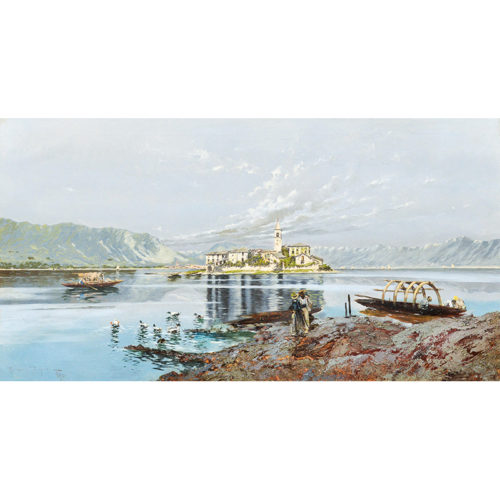 Period: 1896 Measurements: In frame H 87 x L 143 / Canvas H 65 x L 121 cm"Lake Maggiore" - Large oil painting on canvas by Riccardo Pellegrini (1863-1934), depicting the Fishermen's Island seen from a coast. Restored, with contemporary frames. PELLEGRINI RICCARDO. Born in Milan on 11 March 1863, died in Crescenzago (Mi) on 31 March 1934. He studied in his city, then in Rome, and in Naples with Domenico Morelli. He travelled to Spain, England and France to deepen his artistic knowledge. In 1912 he won the Muller house competition in London for the illustrations of the Gil Blas of Le Sage. Then the illustrations for "Don Quixote" were commissioned. The main magazines in Europe collaborated with him. He rarely exhibited in Italy, but always with success. His sketch Malta is located in the Berlin Art Museum; La ridda, in the Gofort Museum in Stuttgart; The kiss of sun, in the Goupil Gallery in Paris. The drawings made for the "Gil Blas" were collected in a room dedicated to the Pilgrims in the Glasgow Museum. The Bottega di Poesia exhibition held in Milan in 1926 featured: A carpet market in Spain; Winter quiet; Sun of July; One August morning in Toledo; Valencian Sea; The spouses. Other works: Spanish flower market, in the R.O. collection of Rome, one of his best works; Villereccia party, in the Rovelli collection of Milan; The antiquarian, in the Ruffini collection in Milan; In the market (Xeres); Sur la promenade des Anglais; Notes of Spain; Remembrance of Seville; I remember my country; El picador; El primer espada; View of Seville; Spanish types; A bullfighter.
Period: 1896 Measurements: In frame H 87 x L 143 / Canvas H 65 x L 121 cm"Lake Maggiore" - Large oil painting on canvas by Riccardo Pellegrini (1863-1934), depicting the Fishermen's Island seen from a coast. Restored, with contemporary frames. PELLEGRINI RICCARDO. Born in Milan on 11 March 1863, died in Crescenzago (Mi) on 31 March 1934. He studied in his city, then in Rome, and in Naples with Domenico Morelli. He travelled to Spain, England and France to deepen his artistic knowledge. In 1912 he won the Muller house competition in London for the illustrations of the Gil Blas of Le Sage. Then the illustrations for "Don Quixote" were commissioned. The main magazines in Europe collaborated with him. He rarely exhibited in Italy, but always with success. His sketch Malta is located in the Berlin Art Museum; La ridda, in the Gofort Museum in Stuttgart; The kiss of sun, in the Goupil Gallery in Paris. The drawings made for the "Gil Blas" were collected in a room dedicated to the Pilgrims in the Glasgow Museum. The Bottega di Poesia exhibition held in Milan in 1926 featured: A carpet market in Spain; Winter quiet; Sun of July; One August morning in Toledo; Valencian Sea; The spouses. Other works: Spanish flower market, in the R.O. collection of Rome, one of his best works; Villereccia party, in the Rovelli collection of Milan; The antiquarian, in the Ruffini collection in Milan; In the market (Xeres); Sur la promenade des Anglais; Notes of Spain; Remembrance of Seville; I remember my country; El picador; El primer espada; View of Seville; Spanish types; A bullfighter. -
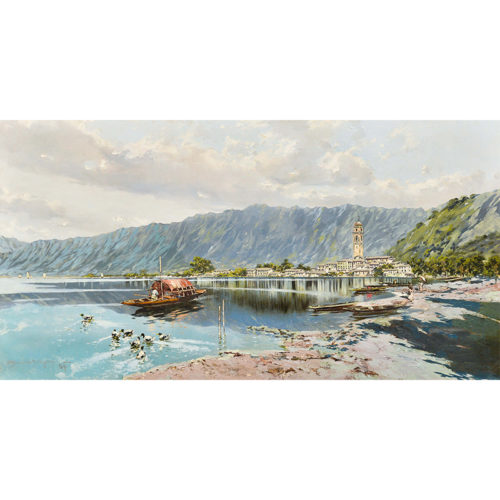 Period: 1896 Measurements: In frame H 87 x L 143 / Canvas H 65 x L 121 cm"Lago Maggiore" - Large oil painting on canvas by Riccardo Pellegrini (1863-1934), depicting a landscape on the shores of Lake Maggiore. Restored, with coeval frame. PELLEGRINI RICCARDO. Born in Milan on 11 March 1863, died in Crescenzago (Mi) on 31 March 1934. He studied in his city, then in Rome, and in Naples with Domenico Morelli. He travelled to Spain, England and France to deepen his artistic knowledge. In 1912 he won the Muller house competition in London for the illustrations of the Gil Blas of Le Sage. Then the illustrations for "Don Quixote" were commissioned. The main magazines in Europe collaborated with him. He rarely exhibited in Italy, but when he did it had always success. His sketch Malta is located in the Berlin Art Museum; La ridda, in the Gofort Museum in Stuttgart; The kiss of sun, in the Goupil Gallery in Paris. The drawings made for the "Gil Blas" were collected in a room dedicated to the Pilgrims in the Glasgow Museum. The Bottega di Poesia exhibition held in Milan in 1926 featured: A carpet market in Spain; Winter quiet; Sun of July; One August morning in Toledo; Valencian Sea; The spouses. Other works: Spanish flower market, in the R.O. collection of Rome, one of his best works; Villereccia party, in the Rovelli collection of Milan; The antiquarian, in the Ruffini collection in Milan; In the market (Xeres); Sur la promenade des Anglais; Notes of Spain; Remembrance of Seville; I remember my country; El picador; El primer espada; View of Seville; Spanish types; A bullfighter.
Period: 1896 Measurements: In frame H 87 x L 143 / Canvas H 65 x L 121 cm"Lago Maggiore" - Large oil painting on canvas by Riccardo Pellegrini (1863-1934), depicting a landscape on the shores of Lake Maggiore. Restored, with coeval frame. PELLEGRINI RICCARDO. Born in Milan on 11 March 1863, died in Crescenzago (Mi) on 31 March 1934. He studied in his city, then in Rome, and in Naples with Domenico Morelli. He travelled to Spain, England and France to deepen his artistic knowledge. In 1912 he won the Muller house competition in London for the illustrations of the Gil Blas of Le Sage. Then the illustrations for "Don Quixote" were commissioned. The main magazines in Europe collaborated with him. He rarely exhibited in Italy, but when he did it had always success. His sketch Malta is located in the Berlin Art Museum; La ridda, in the Gofort Museum in Stuttgart; The kiss of sun, in the Goupil Gallery in Paris. The drawings made for the "Gil Blas" were collected in a room dedicated to the Pilgrims in the Glasgow Museum. The Bottega di Poesia exhibition held in Milan in 1926 featured: A carpet market in Spain; Winter quiet; Sun of July; One August morning in Toledo; Valencian Sea; The spouses. Other works: Spanish flower market, in the R.O. collection of Rome, one of his best works; Villereccia party, in the Rovelli collection of Milan; The antiquarian, in the Ruffini collection in Milan; In the market (Xeres); Sur la promenade des Anglais; Notes of Spain; Remembrance of Seville; I remember my country; El picador; El primer espada; View of Seville; Spanish types; A bullfighter. -
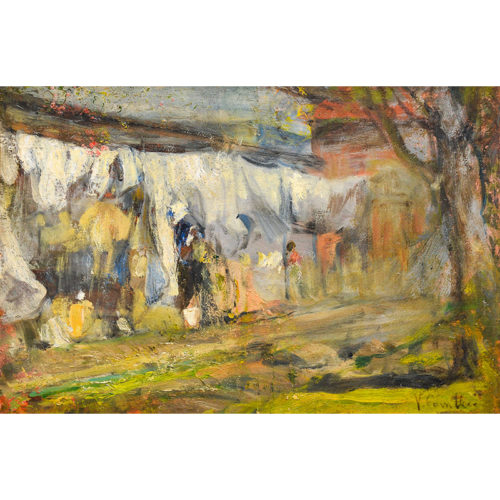 Period: Early 1900s Measurements: In frame H 41 x L 53.5 / Tablet H 24.5 x L 36 cm"Laundry in the sun" - Oil on tablet by Vittorio Cavalleri (1860 - 1938), dating back to the early 1900s. The work is signed in the lower right corner by the author, a Piedmontese painter, son of a cloth merchant, was started by his father for the family's commercial activity. CAVALLERI VITTORIO. Born in Turin in 1860, died in Turin on May 22, 1938. He attended the Accademia Albertina, a pupil of Gamba, Gilardi and Gastaldi. Landscape painter and portraitist, with a robust color, with a strong personality. In 1885 he participated for the first time in the Turin Promoter Exhibition with "Abandoned Hoes" and then frequently exhibited at the Turin exhibitions and the main Italian exhibitions, including the Venice Internationals, until 1925. He also painted sacred subjects, and in the Sanctuary of Oropa found three of his great paintings representing Peace; War and the faithful. Other works: Sad winter; Tonio the gallant; The grandmother and Alpine Flora, preserved in the Civic Museum of Turin; Mountain hospitality in the Marangoni Museum in Udine; In spring; Cemetery flowers; Love story; Empiricism; Ave Maria; Summer in the hills; In the shadow; Baleful Aurora; At home forced; Tribolo; First treasures; Portrait of a man; Domus Aurea; The drowned; Portrait of the Duke of Aosta, in the Gallery of the Order of the Garter at the Court of King Edward of England; Portrait of the mother, in the artist's studio; the Self-portrait, owned by Botto of Milan; Supplizi in the Cartotti collection of Lessona; Ray of sunshine, with Mr. Vittorio Vacchieri; Assalita, Ferrino property; A sunbath, in the Vignolo di Torino collection and the Portrait of Mrs. Pelizzone. Many of his works exist in the Colongo collection in Biella and among them: The shadow; The washerwoman; In adoration; At the source; Theater interior; Sleeping girl. His pupils were: Giuseppe Moreno, Domenico Motta, E. Nicolello, Ans. Priest.
Period: Early 1900s Measurements: In frame H 41 x L 53.5 / Tablet H 24.5 x L 36 cm"Laundry in the sun" - Oil on tablet by Vittorio Cavalleri (1860 - 1938), dating back to the early 1900s. The work is signed in the lower right corner by the author, a Piedmontese painter, son of a cloth merchant, was started by his father for the family's commercial activity. CAVALLERI VITTORIO. Born in Turin in 1860, died in Turin on May 22, 1938. He attended the Accademia Albertina, a pupil of Gamba, Gilardi and Gastaldi. Landscape painter and portraitist, with a robust color, with a strong personality. In 1885 he participated for the first time in the Turin Promoter Exhibition with "Abandoned Hoes" and then frequently exhibited at the Turin exhibitions and the main Italian exhibitions, including the Venice Internationals, until 1925. He also painted sacred subjects, and in the Sanctuary of Oropa found three of his great paintings representing Peace; War and the faithful. Other works: Sad winter; Tonio the gallant; The grandmother and Alpine Flora, preserved in the Civic Museum of Turin; Mountain hospitality in the Marangoni Museum in Udine; In spring; Cemetery flowers; Love story; Empiricism; Ave Maria; Summer in the hills; In the shadow; Baleful Aurora; At home forced; Tribolo; First treasures; Portrait of a man; Domus Aurea; The drowned; Portrait of the Duke of Aosta, in the Gallery of the Order of the Garter at the Court of King Edward of England; Portrait of the mother, in the artist's studio; the Self-portrait, owned by Botto of Milan; Supplizi in the Cartotti collection of Lessona; Ray of sunshine, with Mr. Vittorio Vacchieri; Assalita, Ferrino property; A sunbath, in the Vignolo di Torino collection and the Portrait of Mrs. Pelizzone. Many of his works exist in the Colongo collection in Biella and among them: The shadow; The washerwoman; In adoration; At the source; Theater interior; Sleeping girl. His pupils were: Giuseppe Moreno, Domenico Motta, E. Nicolello, Ans. Priest. -
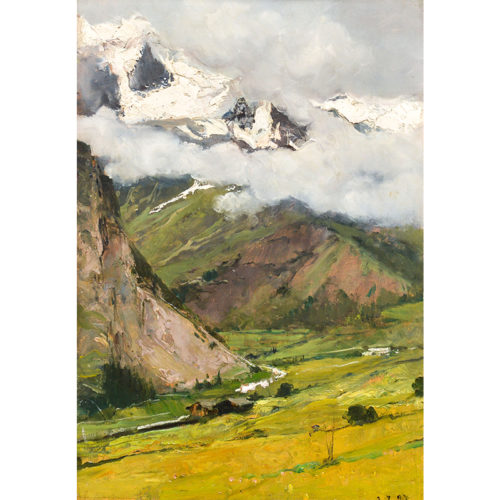 "Mountain landscape, Aosta Valley" - Oil on tablet by Lorenzo Delleani, dated lower right 3.7.97, on the authentic back of Bistolfi. Authenticated by the Piedmontese figurative painters and sculptors archive. DELLEANI LORENZO. Born in Pollone (Biella) on 17 January 1840, died in Turin on 13 November 1908. He studied at the Albertina Academy, a pupil of Gamba for drawing, then of Carlo Arienti and Andrea Gastaldi, graduating in 1862 when he had already made his debut as Promoter of Fine Arts in 1855 and established itself in 1860 with an episode of the siege of Ancona. According to the romantic interests of his time, he initially dedicated himself to painting of historical re-enactment, to achieve more spontaneous research on the truth with interior studies, environment and views of Genoa, Venice and the surroundings of Turin, as well as Pollone and Paris. At the national exhibition in Turin in 1880 the Ministry of Grace and Justice purchased the vast canvas Caterina Grimani Dogaressa, while critics showed that they preferred In the garden. The following year, in Milan, alongside Sebastiano Veniero who presented the prisoners of Lepanto, he exhibited Quies, who earned him numerous acclaim, such as to induce him to abandon historical subjects to devote himself to the landscape, establishing himself for his genuineness and brightness. In addition to the large canvases destined for numerous national and international exhibitions, in which he participated in Italy and abroad, Delleani linked his name to a vast pictorial production made almost exclusively on small panels, "among the most convincing things in the Italian landscape of that age » (Lavagnino). Among his disciples we mention: Giuseppe Bozzalla, Sofia of Bricherasio, Giuseppe Buscaglione, Luigi Cantò, Giuseppe A. Levis, Angela Meucci, Camilla Bergonzio, Emilia Ferrettini Rossotti, Enrico Reycend. Delleani was in Paris and Bern in 1878, in Holland in 1883, Switzerland in 1892, but for his paintings he aimed above all at the reasons that nature and the environment could suggest to him during his periodic stays in the Biella area, in Venice, in Rome, on the Riviera , in the Monferrato. Period: 07/07/97 Measures: In frame H 67 x L 53 x P 6.5 / Table H 45 x L 31 cm
"Mountain landscape, Aosta Valley" - Oil on tablet by Lorenzo Delleani, dated lower right 3.7.97, on the authentic back of Bistolfi. Authenticated by the Piedmontese figurative painters and sculptors archive. DELLEANI LORENZO. Born in Pollone (Biella) on 17 January 1840, died in Turin on 13 November 1908. He studied at the Albertina Academy, a pupil of Gamba for drawing, then of Carlo Arienti and Andrea Gastaldi, graduating in 1862 when he had already made his debut as Promoter of Fine Arts in 1855 and established itself in 1860 with an episode of the siege of Ancona. According to the romantic interests of his time, he initially dedicated himself to painting of historical re-enactment, to achieve more spontaneous research on the truth with interior studies, environment and views of Genoa, Venice and the surroundings of Turin, as well as Pollone and Paris. At the national exhibition in Turin in 1880 the Ministry of Grace and Justice purchased the vast canvas Caterina Grimani Dogaressa, while critics showed that they preferred In the garden. The following year, in Milan, alongside Sebastiano Veniero who presented the prisoners of Lepanto, he exhibited Quies, who earned him numerous acclaim, such as to induce him to abandon historical subjects to devote himself to the landscape, establishing himself for his genuineness and brightness. In addition to the large canvases destined for numerous national and international exhibitions, in which he participated in Italy and abroad, Delleani linked his name to a vast pictorial production made almost exclusively on small panels, "among the most convincing things in the Italian landscape of that age » (Lavagnino). Among his disciples we mention: Giuseppe Bozzalla, Sofia of Bricherasio, Giuseppe Buscaglione, Luigi Cantò, Giuseppe A. Levis, Angela Meucci, Camilla Bergonzio, Emilia Ferrettini Rossotti, Enrico Reycend. Delleani was in Paris and Bern in 1878, in Holland in 1883, Switzerland in 1892, but for his paintings he aimed above all at the reasons that nature and the environment could suggest to him during his periodic stays in the Biella area, in Venice, in Rome, on the Riviera , in the Monferrato. Period: 07/07/97 Measures: In frame H 67 x L 53 x P 6.5 / Table H 45 x L 31 cm
